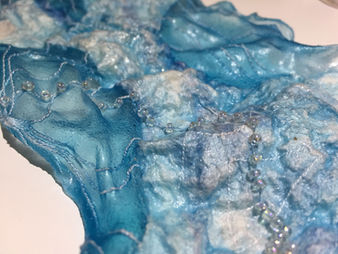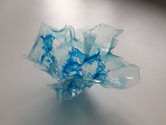
Biosaturate. Graduate Project
date. 2021
Biosaturate is a collection of textile artefacts designed to evoke curiosity and a sense of exploration. The speculative artefacts are a product of my year-long passion for biomaterial innovation that was ignited by general research into plastic pollution and ways to counter this devastating environmental issue. The “Breaking the Plastic Wave” study by PEW Charitable Trust and System IQ was which considering specifically plastic within the ocean, was particularly moving. Using the tacit knowledge base gained through Biolluminate, this collection continues to explore the combination of handmade agar bioplastic and natural textiles.
Thematic details within the artefacts are inspired by examining the way water interacts with the natural world. The artefacts lure viewers to experience their glass-like reflection, movement and organic detail. Each piece delivers a unique visual and haptic experience through the use of fluid structural details and semi-transparent biomaterial. In contrast to biomaterial innovation projects which aim to replicate hard synthetic plastics, Biosaturate prioritises preserving the textile qualities of drape, flexibility, and softness. Here lies potential to continue to explore how biomaterials can be integrated more universally into commercial items, with this project acting as a conversation-starter for further development.
Design decisions were formed with the intention to deliver unusual and wondrous experiences, as well as the end-of-life intention of composability. The pieces demonstrate the incredible saturation that can be achieved using natural dyestuff embedded in bioplastic. A palette was formed through extracting colour from madder, brazilwood, weld, spirulina, and butterfly pea flower. The introduction of machine embroidery into dissolvable material allowed the development of flexible bioplastic x natural fabric hybrid materials, as the impact of covid 19 meant that initial access to a laser cutter was removed.
This collection strives to demonstrate the untapped variety of flexible and strong biotextiles and encourage conversation about, and development into, innovative biomaterials as we move towards a post-petrochemical world.
Collection
The Final Collection of Textile Artefacts comprises of seven pieces, all featuring a degree of bioplastic hybrid materials, felting, wire structures and embroidery.

Lapis Splash




45cm x 46cm x 42cm
Wool, cotton, agar bioplastic, artist’s ink (blue and black), butterfly pea flower, steel wire
Wave




17cm x 12cm x 37cm
Wool, cotton, agar bioplastic, artist’s ink (blue and black), butterfly pea flower, steel wire
Effervescent Algae




110cm x 105cm x 2cm
Wool, cotton, agar bioplastic, madder, weld, green spirulina, steel wire
Autumn River




25cm x 18cm x 1cm
Wool, cotton, agar bioplastic, madder, weld, glass beads
Deep Ripple




14cm x 18cm x 2cm
Cotton, agar bioplastic, artist’s ink (blue and black), butterfly pea flower
Cerise Swirl




27cm x 15cm x 10cm
Wool, cotton, agar bioplastic, madder, weld, steel wire
Swan




14cm x 10cm x 10cm
Wool, cotton, agar bioplastic, weld, steel wire
Inspiration
Context
Coming across the Ellen MacArthur Foundation's response to the “Breaking the Plastic Wave" study evoked a sense of urgency.
The study shows that, if we fail to act, by 2040:
-
the volume of plastic on the market will double
-
the annual volume of plastic entering the ocean will almost triple, from 11m tonnes in 2016 to 29m tonnes in 2040
-
ocean plastic stocks will quadruple, reaching over 600m tonnes
This information encouraged me to pursue a project with circular design at the forefront of design decisions.

Theme
Thematic inspiration was drawn from original photography studying the way water interacts with the natural environment. Details of reflection, flow, frost and droplet formation were interpreted into elements of line and shape, which then formed a base for sculptural motifs and patterns to be established. In particular, circular and tear-drop shapes were explored through both two-dimensional pattern and three-dimensional texture.

Colour
Colour in this project was defined by both thematic and material-based influences. Building on the warm palette of natural materials discovered in Biolluminate, this palette further explored the realm of natural colour possibilities, introducing brazilwood, butterfly pea flower and green spirulina into the mix.
The theme of water was an important factor of the palette expansion into cool hues, and it was interesting to observe how the various natural materials influenced the texture of the bioplastic created. For example, the green spirulina was such a fine powder that rather than producing a shiny finish, it was matte and almost suede-like to touch. This allowed me to be calculated with how I used colour to also impact other sensory elements of the work.
Play
Playful experimentation with materiality is an essential part of my practice. Some of these playtests ended up differently to how I expected, but every test provided additional insight into the materials that I was working with so were equally as valuable.
Ideation
This project initially started with the intention to create a very commercial-focused outcome range of rainwear garments/objects. However, throughout the material investigation process I came across the exciting glass-like reflection features of my materials and had the desire to push this experience in a more speculative direction.
Ideation at this point started creeping into the realm of costume, and I was excited about this idea of creating a collection of artefacts that the user can interact with, that convey a sense of delicacy, rarity, and elegance.
While preserving the textile qualities of drape, flexibility, and softness these artefact ideas focus on the head, some encapsulating the user’s face, others being more for the viewers benefit. The artefact ideas were designed close to the skin to capture the colours of the bioplastic reflection when in the sun.




































